Agrivoltaics, a winning solution
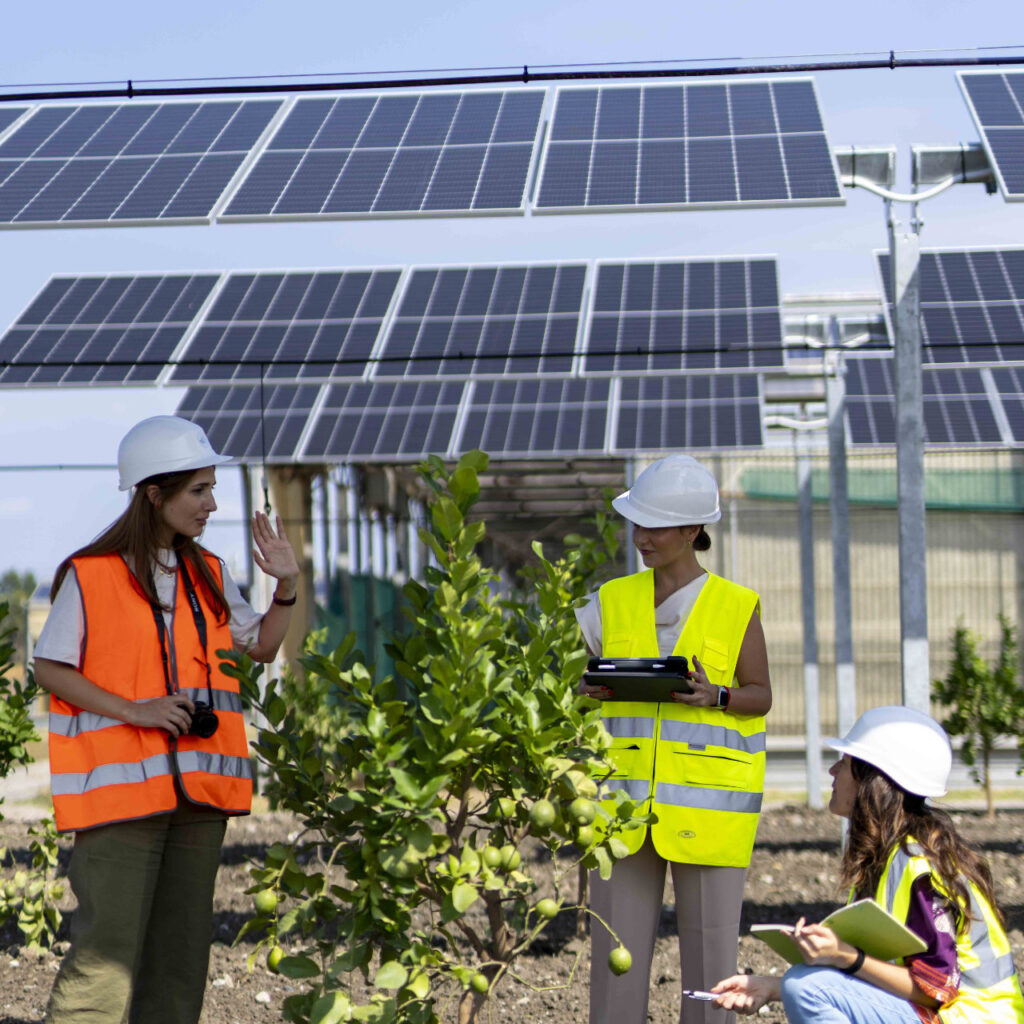
Global agriculture must face the challenge of more sustainable food production, while renewable energy plays an increasingly central role in decarbonization and combating climate change.
Agrivoltaics offers an innovative solution, combining photovoltaic systems, installed above or between crops, with agricultural activities, creating a synergy between the two sectors.
For over 10 years, EF Solare Italia has been developing agrivoltaic systems in Italy to increase the production of clean energy and support agriculture.
This technology enables efficient land use, merging energy and agricultural needs, with benefits for the environment and local communities, promoting biodiversity and generating value for the territory.
Benefits of agrivoltaics
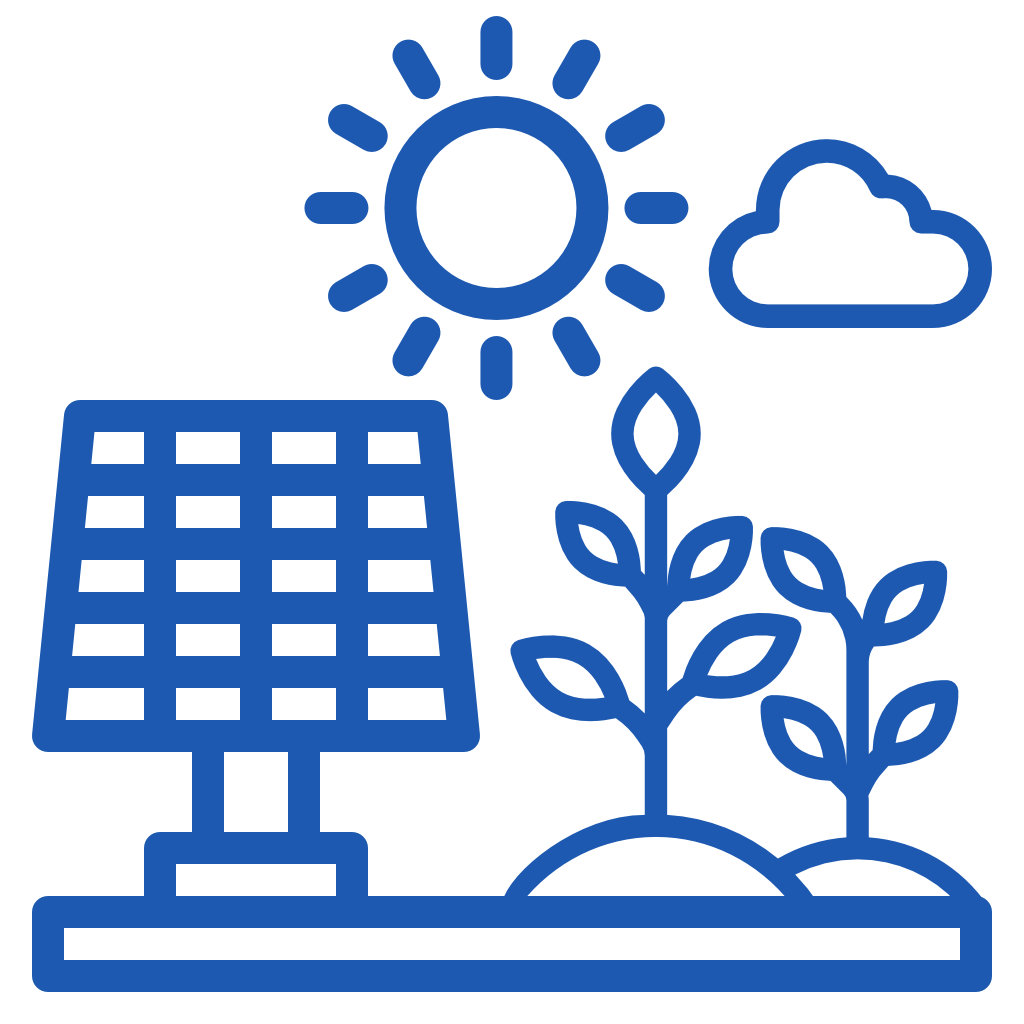
It enables dual land use combats the abandonment of agricultural land, and protects crops from extreme weather events, high temperatures, and new pests.

It promotes value-sharing between agricultural and energy companies, encourages investments to improve agricultural competitiveness through digitalization, land diversification, and the reduction of seasonal risks.

It increases the efficiency of photovoltaic modules thanks to the cooler microclimate generated beneath the panels and helps reduce water needs, shielding crops from heat.

It enhances photosynthetic capacity leading to better yields of high-quality crops, especially for certain crops and climatic conditions.
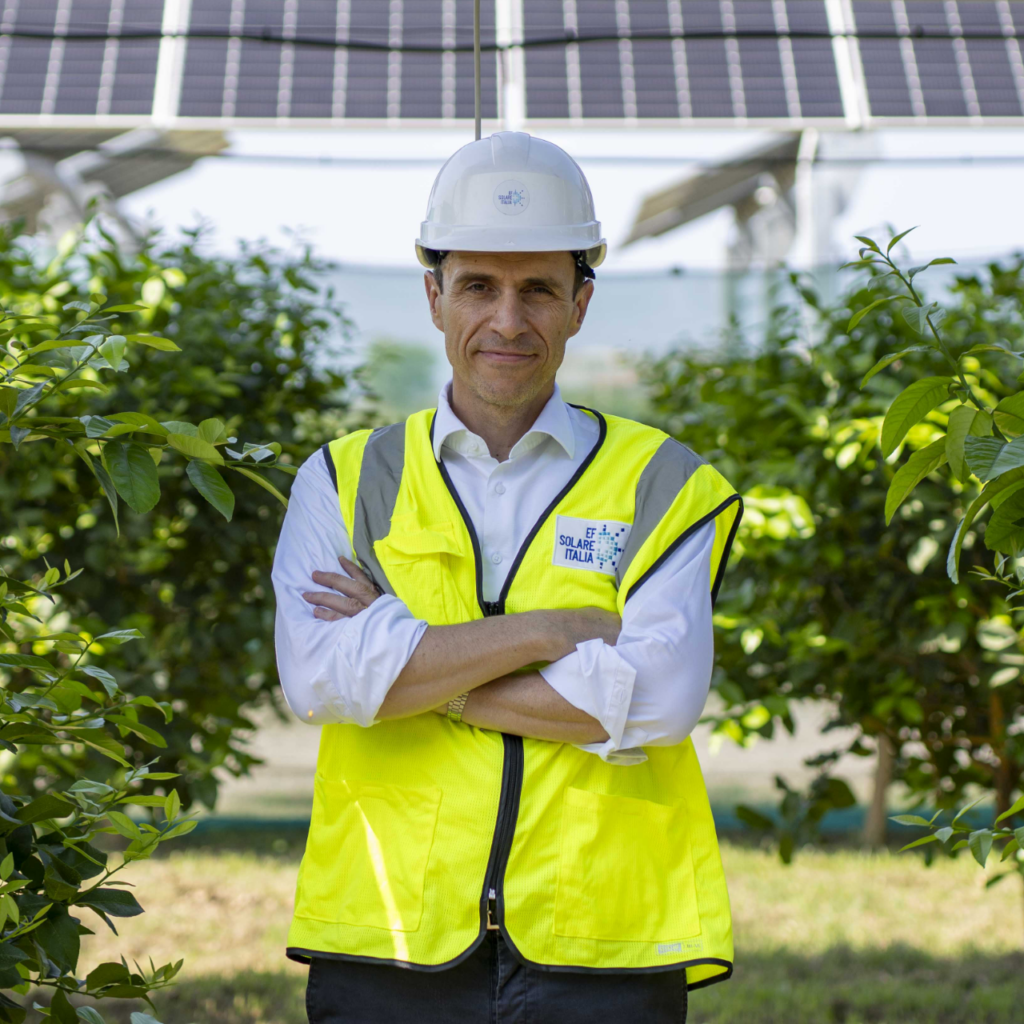 Andrea Ghiselli, CEO of EF Solare Italia, at the agrivoltaic plant in Scalea.
Andrea Ghiselli, CEO of EF Solare Italia, at the agrivoltaic plant in Scalea.
Developing agrivoltaic solutions is essential to meet the ambitious renewable energy growth targets for national and international climate neutrality.
In a global context of climate change, with increasingly hotter summers and severe floods, agrivoltaic systems not only enable dual land use but also help conserve water, protect crops, and generate clean energy.
This is why, for years, we have been developing technologically advanced agrivoltaic systems that create the perfect synergy between agriculture and renewable energy production.
Andrea Ghiselli
Our experience in agrivoltaics
EF Solare Italia has been investing in agrivoltaics for over 10 years, being one of the first companies to build photovoltaic greenhouses in the province of Cosenza, Calabria. To ensure the necessary agricultural expertise, it formed a partnership with “Le Greenhouse”, a family business that blends agricultural tradition with innovation. Thanks to the positive results achieved, EF Solare expanded the photovoltaic greenhouse model to Umbria and Sardinia.
Currently, EF Solare Italia’s photovoltaic greenhouses generate over 44 million kWh of electricity per year, enough to meet the needs of more than 16,000 households, reducing CO2 emissions by over 20,000 tons. The crops grown include lemons, citrons, oranges, and Goji berries, selected based on the characteristics of the land. The greenhouses allow for remote monitoring through sensors that track the conditions of the plants, photovoltaic panels, and irrigation.
Technology for sustainability
The technologies employed enable sustainable management, optimizing the use of resources, particularly water. In the greenhouses in Scalea, for example, up to 70% less water is used compared to traditional farming, and the protection offered by the panels reduces agricultural waste, maintaining the high aesthetic quality of the products. Moreover, the microclimate created beneath the panels supports the cultivation of lemons with characteristics similar to those of PGI (Protected Geographical Indication) varieties.
In collaboration with Le Greenhouse, EF Solare develops projects that protect biodiversity and produce clean energy. Among these are the introduction of smart beehives, powered by small solar panels, which monitor the well-being of the bees.
Our results
0
of photovoltaic greenhouses
MW
0
cultivated plants
thousand
0
kWh produced annually
million
0
tons of CO2 emission saved per year
thousand
The New Agrivoltaic Model
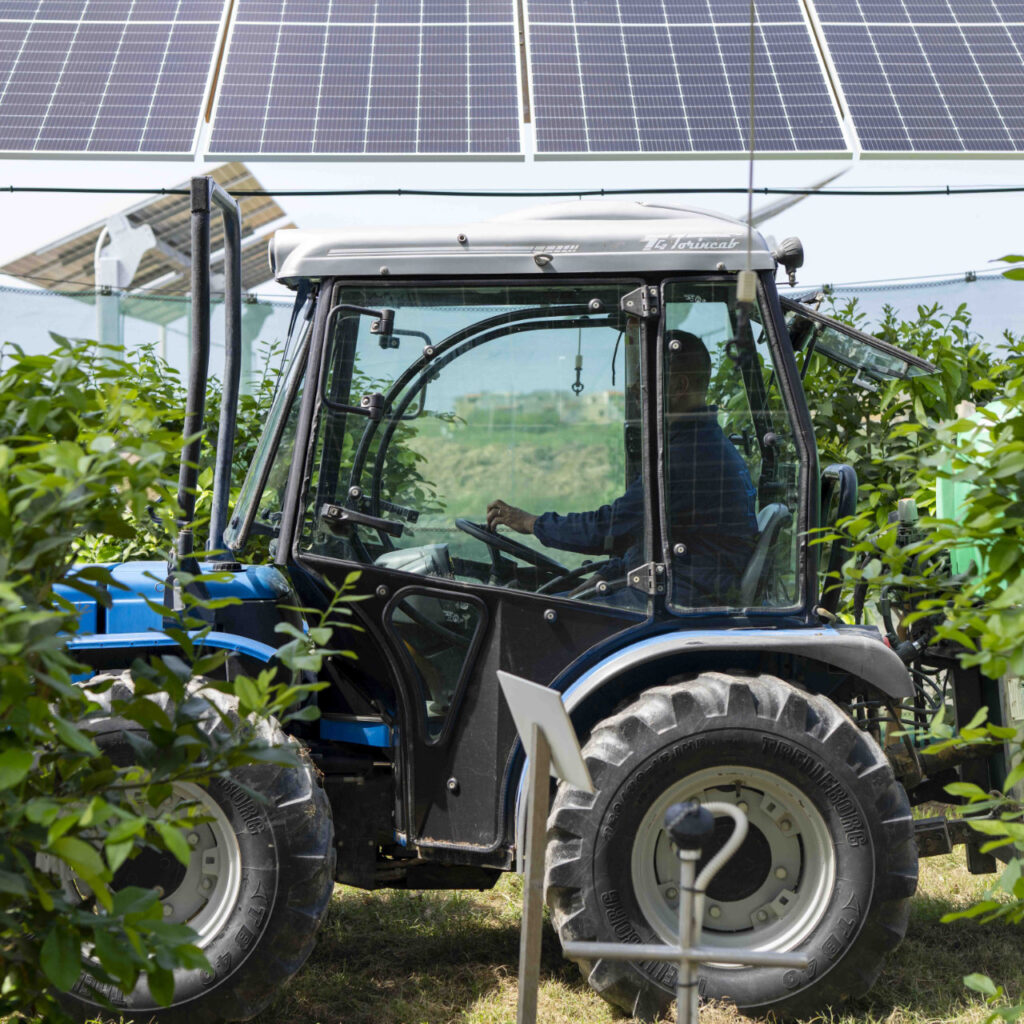
The experience with photovoltaic greenhouses has inspired the creation of a new agrivoltaic model with zero land consumption, introduced in 2021 in Scalea. The system, suitable for all types of solar panels, consists of ground-mounted structures, elevated about 3 meters high, without the use of concrete. It features solar tracking systems, with adequately spaced rows.
Based on a study of the area’s characteristics and the development of a land improvement plan, the new configuration developed by EF Solare Italia allows for full reversibility of the installation and the total cultivation of the involved areas. It ensures the simultaneous and continuous presence of agricultural activities alongside the operation of the photovoltaic system on the same land.
The new agrivoltaic system includes a sophisticated monitoring system, also manageable remotely, that measures various factors such as air and soil humidity, temperature, and plant growth. Additionally, this setup ensures the right balance of direct and diffuse light, benefiting crop growth.
Thanks to the collaboration and effort of all those involved, it was possible to create an innovative agrivoltaic model, capable of meeting the needs of open-field cultivation. Alongside the photovoltaic greenhouse model, it helps maintain and modernize agricultural traditions, making them more sustainable.
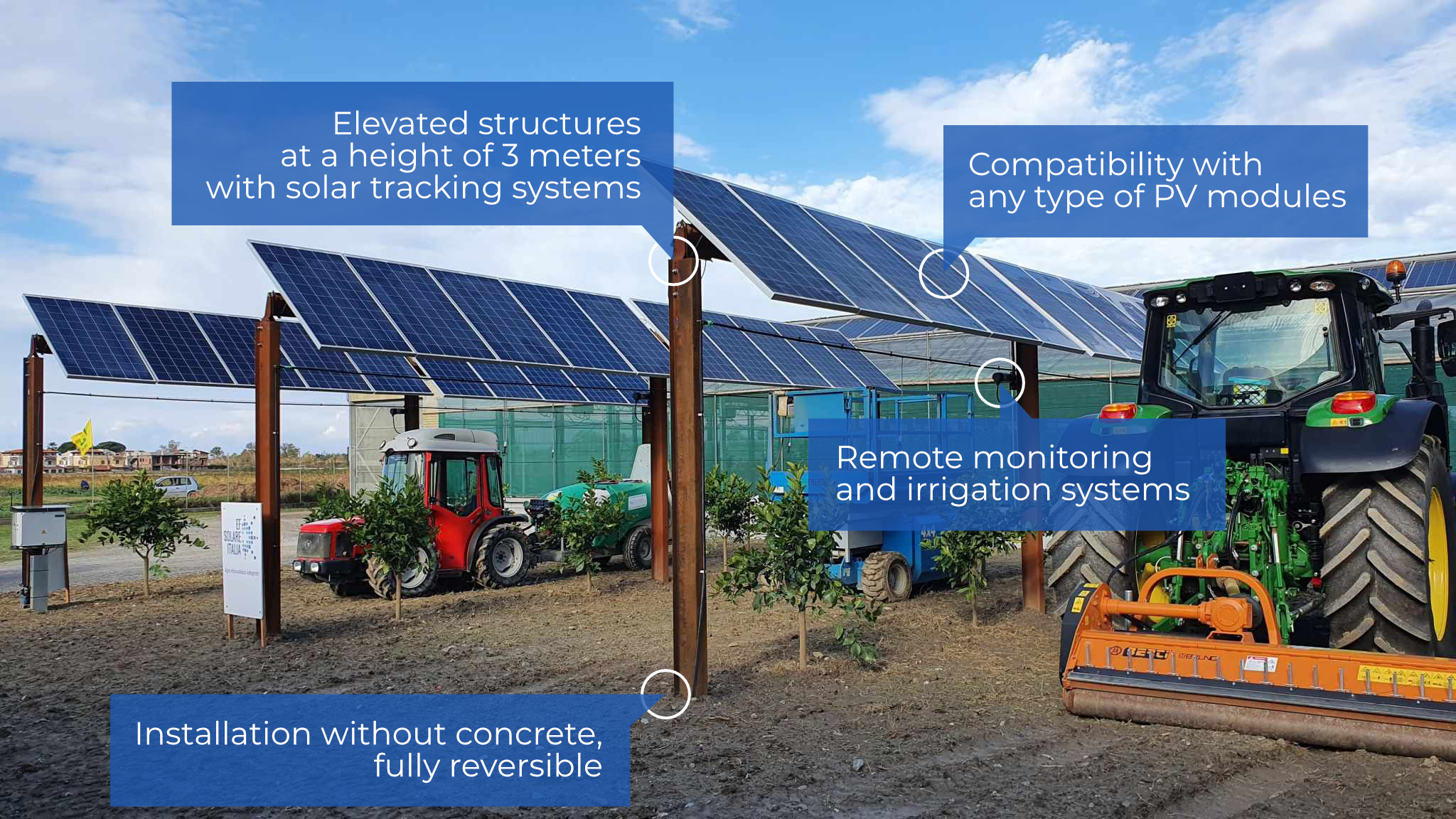
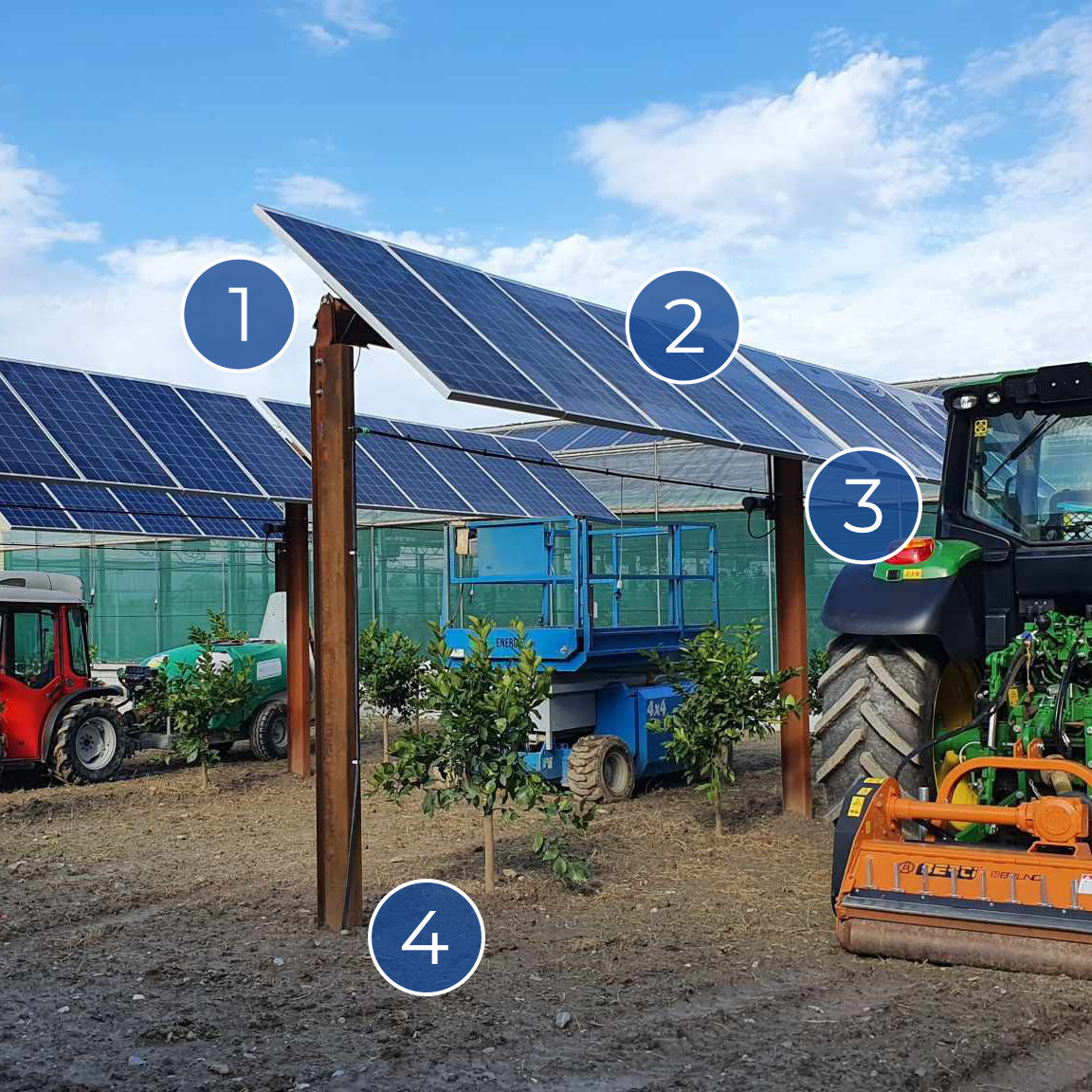
1. Elevated structures at a height of 3 meters with solar tracking systems
2. Compatibility with any type of PV modules
3. Remote monitoring and irrigation systems
4. Installation without concrete, fully reversible
A Constant Technological Progress
The panels are elevated from the ground and arranged in spaced rows to allow the passage of agricultural machinery.
The steel structures are anchored to the ground without the use of concrete.
Sun-tracking technology (similar to how sunflowers follow the sun) is used, along with bifacial modules to capture energy as efficiently as possible.
The structures support overhead irrigation and misting systems.
A complex monitoring system measures various parameters such as temperature, humidity, plant growth, and vegetative conditions.
In addition to producing clean energy, elevated agrivoltaics offers the following benefits:
Like open fields
- Full use of agricultural land (zero land consumption).
- Comparable crop density, using the same agricultural machinery.
Better than open fields
- Reduced water consumption.
- Greater protection from extreme weather events.
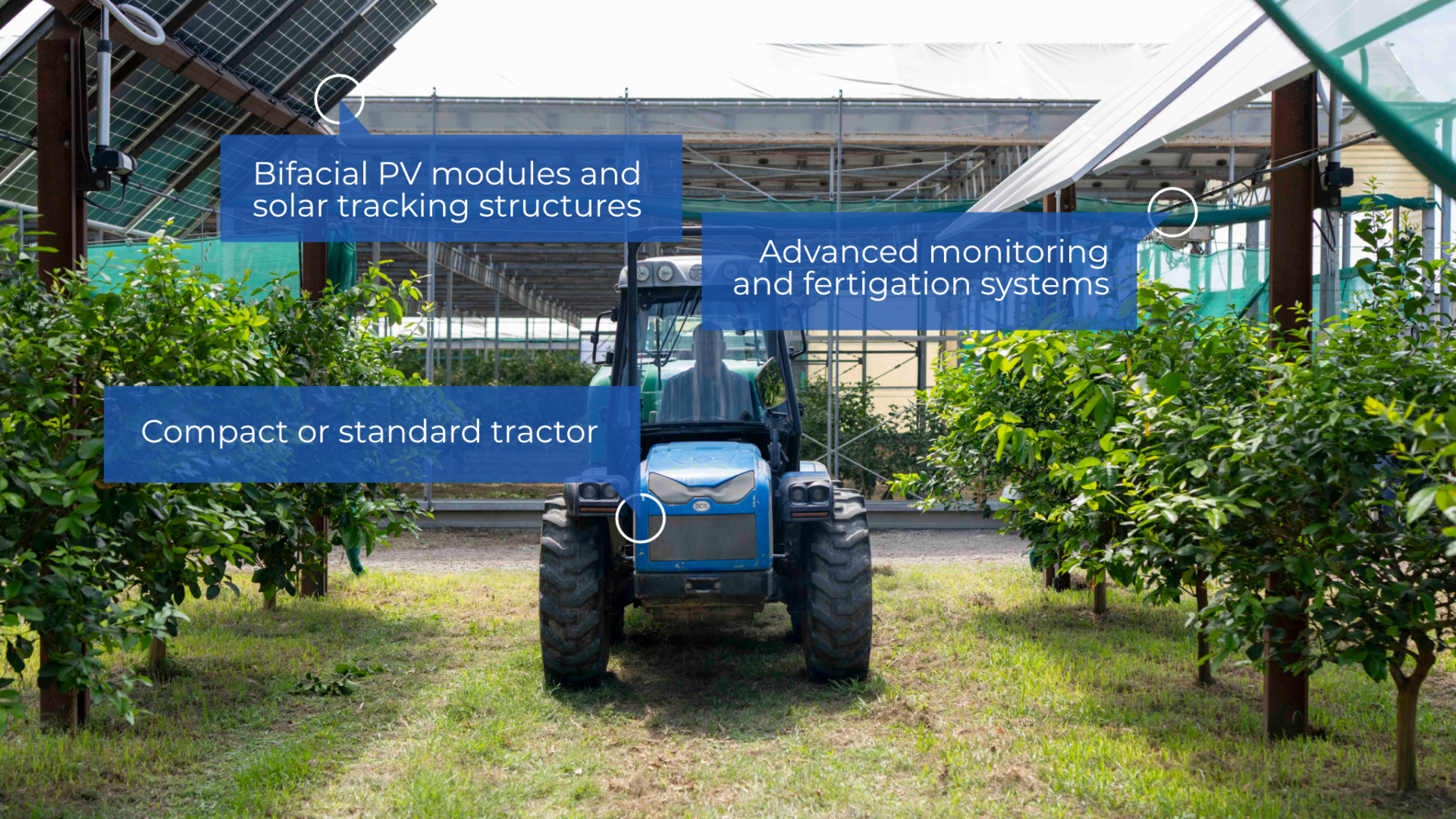
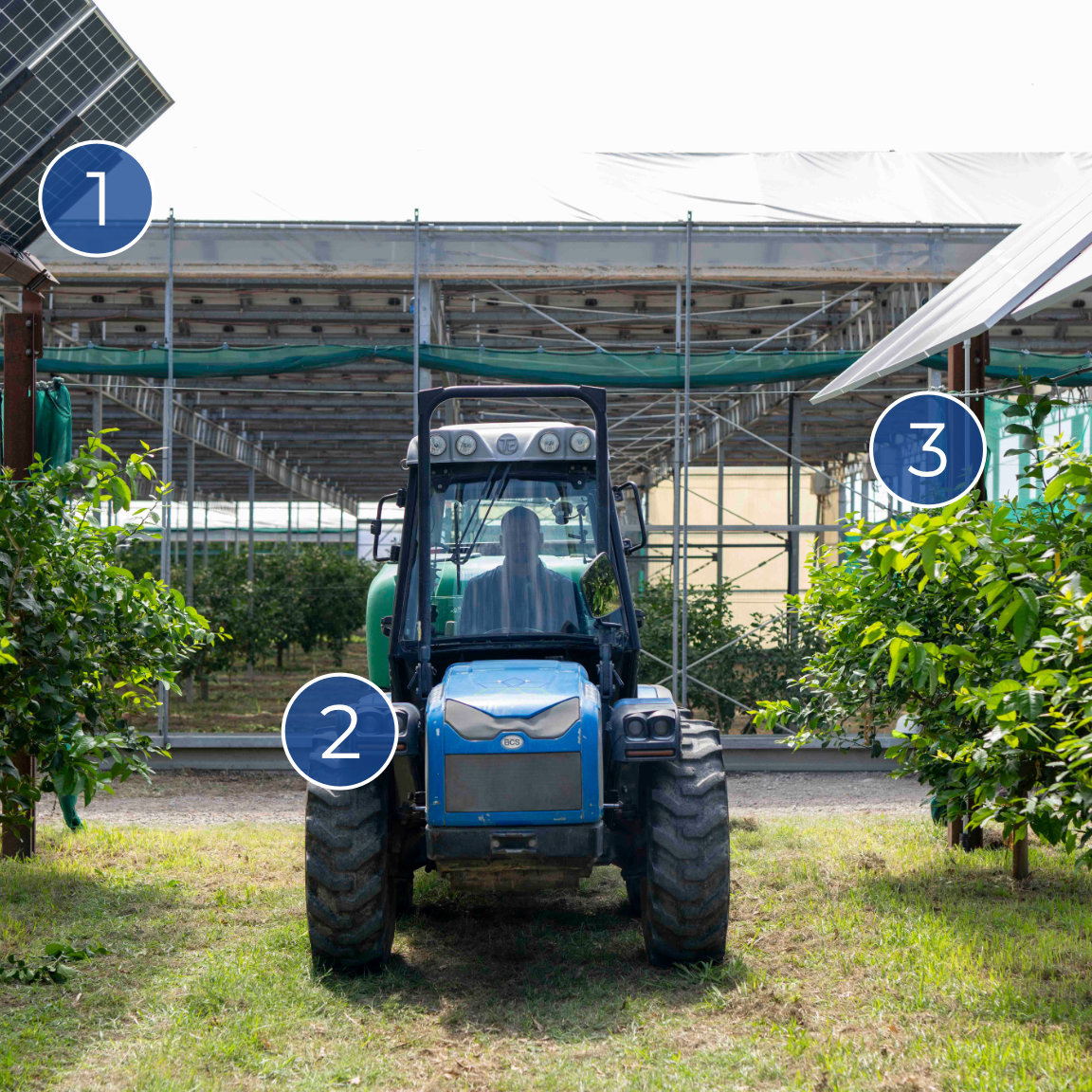
1. Bifacial PV modules and solar tracking structures
2. Compact or standard tractor
3. Advanced monitoring and fertigation systems
Research and Development Projects
Agrivoltaic systems enable the alignment of the power sector’s decarbonization goals with the preservation of agricultural activities. The development of agrivoltaic installations holds strategic importance to achieve the necessary installation growth rate required to meet the 2030 decarbonization targets and to fulfill national electricity demand.
Scientific research in the agrivoltaic sector serves a dual purpose:
– Identifying a technical/operational model that creates shared value, demonstrating that the relationship between photovoltaics and agriculture is not a trade-off, but a synergistic system with benefits for all stakeholders involved.
– Developing scalable, standardized, and economically advantageous project and technological solutions to enhance the competitiveness of agrivoltaics in Italy and across Europe.
The Symbiosyst Project
EF Solare Italia is a participant in the European Symbiosyst project, funded by Horizon Europe and coordinated by Eurac Research of Bolzano. This four-year project aims to develop optimized solutions to reconcile energy production with agricultural needs, reducing emissions, preserving landscapes, and supporting local economies. The goal is to make agrivoltaics increasingly competitive and to promote its role in public discourse.
Symbiosyst will establish several demonstration plants. As the leader of Work Package 5, EF Solare will coordinate the development of a prototype integrated into an apple orchard in Bolzano, while other installations will be set up in Spain (on horticultural crops) and in the Netherlands (photovoltaic greenhouses). These prototypes will test adaptable technologies for different crops and geographical contexts. The project aims to integrate solar energy generation with crop requirements, optimizing factors such as panel height and light distribution.
Preliminary results have shown that, under certain conditions, agrivoltaics can enhance both crop yield and renewable energy production. Additionally, indicators have been defined to assess the sustainability of agrivoltaic systems, taking into account energy efficiency, agricultural productivity, and environmental impact.
Research Project with ENEA
As part of the “High-Efficiency Photovoltaics” project, ENEA has intensified its research on agrivoltaics. This approach limits land use, recovers agricultural areas, and revitalizes farming activities. ENEA and EF Solare Italia have established a partnership to conduct a study at the experimental site in Scalea, Calabria, with the aim of comparing two types of agrivoltaic systems: one with single-axis tracking structures and another with fixed modules. The study will analyze the energy performance of the installations, as well as the productivity and quality of crops grown under the panels, compared to those cultivated in open fields. Data collection will be facilitated by advanced monitoring and remote-control systems.
The collaboration also involves Le Greenhouse for agricultural expertise and Set Energie for electrical expertise, both already engaged in the experimental hub due to their deep knowledge of the region, synergy with local communities, and decades of experience in the photovoltaic sector. The experimental hub is equipped with advanced technologies, including high-efficiency bifacial photovoltaic panels and an electrolyte storage system. Additionally, a reverse osmosis desalination plant has been installed to treat brackish water and provide fresh water for crop irrigation. This is complemented by a fertigation system and advanced sensors (such as PAR sensors and dendrometers) to enable precision farming.
FAQ
+
How does agrivoltaics work?
Agrivoltaics combines agricultural or livestock activities and solar energy production. This is possible thanks to the installation of integrated systems with photovoltaic panels elevated above crops or installed between rows in different configurations. Agrivoltaics allows simultaneous land use for crops and renewable energy production, generating numerous benefits for the environment and local communities.
+
What kind of land is best for solar parks?
Flat or gently sloping land is preferred to facilitate installation, maintenance, and agricultural activities. Land should also be free of obstacles that could cast shadows on the panels and reduce energy production. Agrivoltaic systems can enable the restoration of unproductive land and improve agricultural yields in arid climates. Good quality, not too gravelly soils endowed with water resources are preferred for the agricultural part.
+
What can be grown under PV modules?
Based on current knowledge, all kinds of crops are generally suitable for cultivation in agrivoltaic systems, with varying effects on yields depending on the configuration of the system and the shade produced. Crops that tolerate shade best, such as leafy vegetable species (e.g., lettuce), forage species (such as grass and clover), various species of fruit trees (apple, pear, etc), and berries, and other specialty crops (e.g., wild garlic, asparagus, hops) appear to be particularly suitable. Plant height is one aspect to consider.
+
Can agrovoltaics also support livestock farming?
Certainly. It is possible to design models that include animal husbandry within agri-voltaic systems. Raising sheep as well as beekeeping in combination with power generation are widespread practices.
+
What is the best location for building solar power plants?
Photovoltaic systems are designed to maximize solar energy production, so the best location is where they can receive the most solar radiation. Some factors to consider are latitude, shading, and the presence of weather conditions (salinity, sandy rains) or chemicals that can affect the operation of technological components. When it comes to large installations, it is vital to consider the distance to consumption points and grid infrastructure. Photovoltaic systems, however, are truly versatile, because they can produce energy even on cloudy days and in sub-optimal conditions.
Agrivoltaics Stories
AGRIVOLTAICS AS A DRIVER OF EUROPE’S ENERGY TRANSITION
20 December 2023
Boosting electricity generation from solar sources is crucial in making rapid strides in the decarbonization process. In this regard, one of the…
AGRIVOLTAICS 2.0 TO FOSTER ITALIAN AND EUROPEAN DECARBONIZATION: EF SOLARE AT KEY ENERGY 2023
27 March 2023
New perspectives and strategic collaborations to achieve common goals can arise from confrontation. For this reason, every year EF Solare…
AGRO-PHOTOVOLTAICS LESSONS: SCHOOL-WORK ALTERNANCE IN OUR GREENHOUSES
28 June 2022
Every year, EF Solare makes a daily commitment to support and take an active part in important educational events with…
PROTECTION OF BIODIVERSITY BY SUPPORTING THE DEVELOPMENT OF RENEWABLES: SMART BEEHIVES IN EF SOLARE’S PHOTOVOLTAIC GREENHOUSES
20 May 2022
On the occasion of World Bee Day, we want to talk about the project we are carrying out in out…
EF SOLARE’S ANNUAL CONFERENCE, “TRANSITION2GREEN: THE CONTRIBUTION OF AGRI-PHOTOVOLTAICS”
06 December 2021
"Transition2Green: the contribution of agri-photovoltaics" was the title of the annual conference organized by EF Solare that, after a year…
AGRO-PHOTOVOLTAIC: A TOOL FOR THE PRODUCTION OF CLEAN ENERGY THAT IS ALSO GOOD FOR THE TERRITORY
03 August 2021
Italy needs to increase the production of renewable energy and in particular solar to advance in the de-carbonization, in fact,…
PHOTOVOLTAIC GREENHOUSES: THE CO2 PRODUCED IS COMPENSATED IN A VERY SHORT TIME – NICOLETTA AMATO’S THESIS ON OUR ORSOMARSO GREENHOUSE
15 June 2020
Today we tell you the story of Nicoletta Amato, student of the University of Turin Faculty of Economics who, together…
AGRO-PHOTOVOLTAIC: WHEN SOLAR ENERGY INTEGRATES WITH AGRICULTURE AND LIVESTOCK
30 April 2019
Photovoltaics continue to grow in Italy and in the World: the installed capacity in our country is now higher than…
The Riviera of the Cedars – Part II
27 September 2017
The October Feast of Booths (“Sukkoth”) is approaching. In the Riviera of the Cedars Rabbis, who come mainly from Israel…













